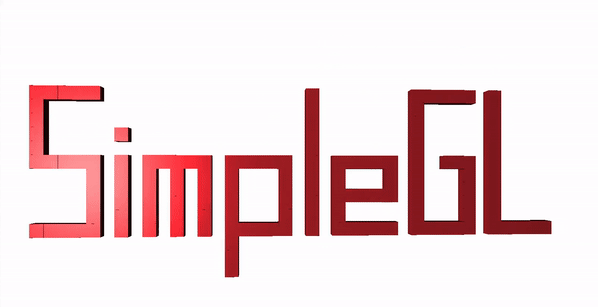 Documentation
¶
Documentation
¶
Index ¶
- func AfterDrawing(window *glfw.Window)
- func BeforeDrawing()
- func BeforeMainLoop(window *glfw.Window, vp *Viewpoint)
- func Init(windowWidth int, windowHeight int, windowTitle string) *glfw.Window
- func InitGlfwAndOpenGL(width int, height int, title string) *glfw.Window
- func MakeProgram(vertexShaderSource, fragmentShaderSource string) uint32
- func NewCube(l float32) *[]float32
- func NewUniTexCube(l float32) *[]float32
- func ReadBinaryStlFile(file string, min float64, max float64) []float32
- func Terminate()
- type BasicNoLightObj
- func (obj *BasicNoLightObj) BindProgramVar(program uint32)
- func (obj *BasicNoLightObj) GetModel() mgl32.Mat4
- func (obj *BasicNoLightObj) GetProgram() uint32
- func (obj *BasicNoLightObj) PrepareProgram(bindProgramVar bool)
- func (obj *BasicNoLightObj) Render()
- func (obj *BasicNoLightObj) SetModel(newModel mgl32.Mat4)
- func (obj *BasicNoLightObj) SetProgram(program uint32)
- func (obj *BasicNoLightObj) SetProgramVar(progVar interface{})
- func (obj *BasicNoLightObj) SetVertices(vertices *[]float32)
- type BasicNoLightObjProgVar
- type BasicObj
- func (obj *BasicObj) BindProgramVar(program uint32)
- func (obj *BasicObj) GetModel() mgl32.Mat4
- func (obj *BasicObj) GetProgram() uint32
- func (obj *BasicObj) PrepareProgram(bindProgramVar bool)
- func (obj *BasicObj) Render()
- func (obj *BasicObj) SetModel(newModel mgl32.Mat4)
- func (obj *BasicObj) SetProgram(program uint32)
- func (obj *BasicObj) SetProgramVar(progVar interface{})
- func (obj *BasicObj) SetVertices(vertices *[]float32)
- type BasicObjProgVar
- type BasicTexObj
- func (obj *BasicTexObj) BindProgramVar(program uint32)
- func (obj *BasicTexObj) GetModel() mgl32.Mat4
- func (obj *BasicTexObj) GetProgram() uint32
- func (obj *BasicTexObj) PrepareProgram(bindProgramVar bool)
- func (obj *BasicTexObj) Render()
- func (obj *BasicTexObj) SetModel(newModel mgl32.Mat4)
- func (obj *BasicTexObj) SetProgram(program uint32)
- func (obj *BasicTexObj) SetProgramVar(progVar interface{})
- func (obj *BasicTexObj) SetVertices(vertices *[]float32)
- type BasicTexObjProgVar
- type Group
- type LightSrc
- type Material
- type Object
- type Viewpoint
Constants ¶
This section is empty.
Variables ¶
This section is empty.
Functions ¶
func AfterDrawing ¶
func BeforeDrawing ¶
func BeforeDrawing()
func BeforeMainLoop ¶
func MakeProgram ¶
func NewUniTexCube ¶
NewUniTexCube will return vertices of a cube with side length l. The vertices contains custom data (texture vector)
Types ¶
type BasicNoLightObj ¶
type BasicNoLightObj struct {
// contains filtered or unexported fields
}
func (*BasicNoLightObj) BindProgramVar ¶
func (obj *BasicNoLightObj) BindProgramVar(program uint32)
func (*BasicNoLightObj) GetModel ¶
func (obj *BasicNoLightObj) GetModel() mgl32.Mat4
func (*BasicNoLightObj) GetProgram ¶
func (obj *BasicNoLightObj) GetProgram() uint32
func (*BasicNoLightObj) PrepareProgram ¶
func (obj *BasicNoLightObj) PrepareProgram(bindProgramVar bool)
func (*BasicNoLightObj) Render ¶
func (obj *BasicNoLightObj) Render()
func (*BasicNoLightObj) SetModel ¶
func (obj *BasicNoLightObj) SetModel(newModel mgl32.Mat4)
func (*BasicNoLightObj) SetProgram ¶
func (obj *BasicNoLightObj) SetProgram(program uint32)
func (*BasicNoLightObj) SetProgramVar ¶
func (obj *BasicNoLightObj) SetProgramVar(progVar interface{})
func (*BasicNoLightObj) SetVertices ¶
func (obj *BasicNoLightObj) SetVertices(vertices *[]float32)
type BasicNoLightObjProgVar ¶
type BasicObj ¶
type BasicObj struct {
// contains filtered or unexported fields
}
func (*BasicObj) BindProgramVar ¶
func (*BasicObj) GetProgram ¶
func (*BasicObj) PrepareProgram ¶
func (*BasicObj) SetProgram ¶
func (*BasicObj) SetProgramVar ¶
func (obj *BasicObj) SetProgramVar(progVar interface{})
func (*BasicObj) SetVertices ¶
type BasicObjProgVar ¶
type BasicTexObj ¶
type BasicTexObj struct {
// contains filtered or unexported fields
}
func (*BasicTexObj) BindProgramVar ¶
func (obj *BasicTexObj) BindProgramVar(program uint32)
func (*BasicTexObj) GetModel ¶
func (obj *BasicTexObj) GetModel() mgl32.Mat4
func (*BasicTexObj) GetProgram ¶
func (obj *BasicTexObj) GetProgram() uint32
func (*BasicTexObj) PrepareProgram ¶
func (obj *BasicTexObj) PrepareProgram(bindProgramVar bool)
func (*BasicTexObj) Render ¶
func (obj *BasicTexObj) Render()
func (*BasicTexObj) SetModel ¶
func (obj *BasicTexObj) SetModel(newModel mgl32.Mat4)
func (*BasicTexObj) SetProgram ¶
func (obj *BasicTexObj) SetProgram(program uint32)
func (*BasicTexObj) SetProgramVar ¶
func (obj *BasicTexObj) SetProgramVar(progVar interface{})
func (*BasicTexObj) SetVertices ¶
func (obj *BasicTexObj) SetVertices(vertices *[]float32)
type BasicTexObjProgVar ¶
type Group ¶
type Group struct {
// contains filtered or unexported fields
}
func (*Group) SetGroupModel ¶
type LightSrc ¶
func NewLightSrc ¶
func NewLightSrc() LightSrc
type Material ¶
type Material struct {
Ambient mgl32.Vec3
Diffuse mgl32.Vec3
Specular mgl32.Vec3
Shininess float32
}
func NewMaterial ¶
func NewMaterial() Material
type Object ¶
type Object interface {
// SetProgramVar sets the program's constant and uniform variables.
SetProgramVar(interface{})
// PrepareProgram prepares a shader program.
// If the arg is true, bind uniform variables,
// otherwise store the program only without binding uniform variables.
PrepareProgram(bool)
// BindProgramVar bind uniform variables to a shader program.
BindProgramVar(uint32)
// SetVertices sets vao and vbo.
SetVertices(*[]float32)
// GetModel gets the model of the object.
GetProgram() uint32
// SetModel sets the model of the object.
SetProgram(uint32)
// GetModel gets the model of the object.
GetModel() mgl32.Mat4
// SetModel sets the model of the object.
SetModel(mgl32.Mat4)
// Render refreshs uniform variables and draw the object.
// All references of the variables that would change the
// object's states in the main loop (i.e. uniform variables)
// should have already been prepared when calling SetProgramVar(),
// thus we won't do any extra work here to get the best performance.
Render()
}
 Source Files
¶
Source Files
¶
Click to show internal directories.
Click to hide internal directories.



